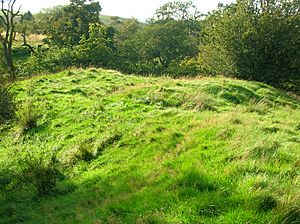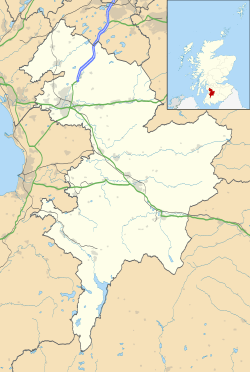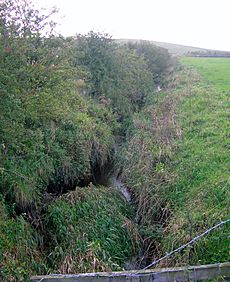Kerse Castle, East Ayrshire facts for kids
Quick facts for kids Kerse Castle |
|
|---|---|
| Kerse, East Ayrshire, Scotland UK |
|

Possible site of the Kerse tower castle
|
|
| Coordinates | 55°23′46″N 4°28′01″W / 55.396°N 4.467°W |
| Site information | |
| Controlled by | Craufurd clan |
| Open to the public |
No |
| Condition | No remains |
| Site history | |
| Built | 13th century |
| In use | Until 17th century |
| Materials | Stone |
Kerse Castle or Carse Castle was an old stone castle in East Ayrshire, Scotland. It was once owned by the powerful Craufurd family. Today, there are no remains of the castle left, but historians believe it was located near the Bow Burn.
Contents
Discovering Kerse Castle's Past
Even though Kerse Castle is gone, we can still learn about its history. No pictures or detailed descriptions of the castle have survived. However, we can find clues about where it once stood. These clues include old walls, ditches, and flat areas where buildings might have been. There are also old apple trees and other plants that were likely planted a long time ago. Old maps and local place names like Kerse Bridge also help us find its location. A railway line built through the area long ago caused some damage to the site.
Why Kerse Castle Disappeared
Kerse Castle was taken apart around 1760. Its stones were used to build a new house called Skeldon House. This was done by a man named Mr. Ross of Sandwick. Later, on a stormy night in December 1797, the last remaining wall of the old castle fell down.
Old Maps Show the Castle
Old maps are very helpful for finding out where Kerse Castle was.
- Robert Gordon's map from around 1640 shows a castle called "Cars" near a loch (a small lake).
- The Blaeu map from about 1654, based on Timothy Pont's map, also shows "Cars Castle" with large grounds and woods.
- Moll's map from 1745 places the castle to the east of the loch.
- Roy's map from 1747 calls it "Carse" and also shows it east of the loch.
- Maps from 1821 and 1832 still show the loch and a dwelling called "Kerse" or "Carse" in the area.
The Craufurd Family of Kerse
The Craufurds of Kerse were an important branch of the larger Craufurd family. They were known for their strong family ties and their special coat of arms, which featured a stag's head.
Early Craufurd Family Members
Reginald Craufurd was the first of the Kerse family. He received the land from his brother Hugh during the time of Alexander III of Scotland (who ruled from 1241 to 1286). Many family members are mentioned in old records. In 1508, David Craufurd of Kerse and several others were fined. They had stopped a local court from meeting. David had to pay five pounds, which was a lot of money back then.
A Family Feud: The Raid of Loudoun
In 1527, Bartholomew Craufurd of Kerse and his brothers, along with other Craufurd family members, were involved in a big fight. They helped Hugh Campbell, the sheriff of Ayr, in a conflict against Gilbert, the Earl of Cassillis. This event was known as the 'Raid of Loudoun'.
Passing on the Estate
David Craufurd of Kerse, a grandson of Bartholomew, only had a daughter. When he died in 1600, the Kerse estate went to Alexander Craufurd of Balgregan. He was the closest male relative. Later, in 1680, another Alexander Craufurd of Kerse inherited more land.
The last male Craufurd owner of Kerse was Alexander Craufurd. His daughter, Christian Crawford, married a Mr. Moodie. They had no children, so she passed the Kerse lands to William Ross of Sandwick. The Ross family then built Skeldon House around 1760. Eventually, the Kerse estate was sold to the Oswald family, who owned it into the 1800s.
Other Family Connections
- John McDougall of Logan, who died in 1618, was married to Margaret Craufurd of Kerse.
- Edward Henry John Craufurd (1816–1881) was a Scottish politician. He was the eldest son of John Craufurd of Auchenames and Kerse.
- Margaret Craufurd of Cumlarg was the daughter of Captain John Craufurd of Camlarg, who was related to the Craufurds of Kerse.
- Joanna Livingston married David Craufurd of Kerse before 1567.
- William Cunynghame of Milncraig married the daughter of David Craufurd of Kerse in the early 1600s.
- In 1595, a Craufurd of Kerse was allowed to accompany Patrick Houston to a meeting with the King at Holyrood Palace.
The Craufurd Coat of Arms
The Craufurd family of Kerse had a special coat of arms. It was described as "Argent (silver), a stag’s head erased Gules (red)." The word 'erased' in heraldry means that the stag's head looks like it was torn off, leaving jagged edges.
Exciting Ayrshire Stories and Legends
The Craufurds of Kerse were known for being a strong and sometimes wild family. They had a lot of land and influence. When David Craufurd needed help, many horsemen and footmen would come from all over the country to support him.
The Craufurds of Kerse: A Powerful Family
The Craufurds played an important part in Scottish history. Sir Reginald Craufurd, who was the uncle of the famous Scottish hero William Wallace, was one of their ancestors. For many years, they held the important job of sheriff of Ayr. The chief of the Craufurd family in the 1500s was very powerful. He was often involved in raids on other lands or fights against rival families.
One story tells of a time when the Craufurd chief was waiting for trial. One of his followers, John Shaw, had killed a man with a stone. The Craufurd chief offered to pay for Shaw, and this was accepted. Shaw had also attacked the home of Duncan Fergusson, the laird of Kilkerran. Shaw and his men broke down walls and destroyed the property. They even attacked one of the laird's servants. But because it was part of an ongoing family feud, the Craufurd chief again offered to pay, and Shaw was allowed to rejoin his friends.
Another time, the Craufurds were unhappy that Lord Eglinton was a local judge. When the Earl held court, the Craufurds caused so much trouble that the judge couldn't make decisions. This was a serious offense! But the Craufurd chief was only fined five pounds, and his family members were fined forty shillings each. This shows how powerful the Craufurds were.
- Views of Kerse Castle and policies
The Raid of Barbieston
This is a famous story about a fight between the Craufurds and the Kennedy family. One night, two Kennedy men, Guiltree and Cloncaird, heard a noise. It was the sound of many horsemen coming from Kerse Castle. They knew it must be the Craufurds, coming after them!
The Kennedys were driving cattle and sheep, probably taken from the Craufurds. They quickly tried to reach a river crossing called a ford. The Craufurds were close behind. The Kennedys decided to send some men ahead with the animals. The rest of them stayed behind to fight the Craufurds.
About sixty Craufurd men arrived. They were ready for a fight. Swords clashed, and horses galloped. The quiet night was filled with the sounds of battle. The Kennedys fought bravely, but the Craufurds pushed forward. The fight continued all the way to the banks of the River Doon.
At the river, the battle ended. Some of the animals escaped, but some were captured. Both sides had wounded men. The Kennedys went to Cassillis Castle, and the Craufurds returned to Kerse Castle. Later, the Craufurds reported the raid to the authorities. The Kennedys had to pay for the lost animals.
The Raid of Loudoun
Lady Loudoun asked Bartholomew Craufurd of Kerse and his brothers, along with other Craufurds, to gather their followers. They planned to ambush the chief of the Kennedys, the Earl of Cassillis, as he returned from Stirling. The Earl was attacked near Prestwick. In return, the Kennedys burned down the old Loudoun Castle.
The Legend of the Flitting of the Sow
This legend is about another feud between the Kennedys of Carrick and the Craufurds of Kyle. Three days before Lammas Day (July 29th), Gilbert Kennedy came to Kerse Castle. He told the old Laird of Kerse that his clan would "tether a sow" on the Craufurds' land on Lammas Day (August 1st). This was a big insult and a challenge to fight!
Both clans gathered their supporters. On Lammas Day, the Laird's eldest son, Elspin, led the Craufurds into battle against the Kennedys. The fight happened on the Craufurds' land near Skeldon. Sadly, John, the Laird's other son, was killed. But the Craufurds won the battle and drove the Kennedys back. Many Kennedys drowned in the River Doon as they tried to escape. A part of the Doon is still called 'Kennedy's Dub'.
The old Laird of Kerse was too old to fight. He waited impatiently on the castle tower, looking for news. Finally, a rider named 'Will o' Ashyntree' arrived. He reported that John had been killed, but the Craufurds had won, and the "sow had not been flitted" (meaning the challenge was met and the insult was not allowed). A poem was even written about this event.
The Laird of Kelwood
John Corrie, the Laird of Kelwood, found an old gold item on the Earl of Cassillis's land. The Earl wanted it, but Kelwood refused to give it up. Kelwood fled to his home, Thomaston Castle. The Earl and another Laird laid siege to the castle. Kelwood had to surrender and give up the gold. He complained to the Privy Council, but not much happened. Kelwood was afraid to go back to his home. He became friends with the Laird of Carse (Kerse), who was an enemy of the Kennedys. The Laird of Kerse sent a strong guard of Craufurd soldiers to take Kelwood safely back to Thomaston Castle.
Kerse Mill: A Busy Place
Two and a half miles down the River Doon from Kerse Castle was Nether Skeldon Mill. This mill was owned by a branch of the Craufurds of Kerse. In 1851, David Templeton was the tenant of the mill.
From Oatmeal to Blankets
The mill used water power from the river. It operated as an oatmeal mill until 1868. Then, a man named William T. Hammond took over. He built a woollen mill on the site to make blankets. He improved the water power by making the river channel deeper. This gave the water wheel more power. Over the years, different types of water wheels were used. In the 1940s, a new turbine was installed. It was very powerful, able to produce 150 horsepower!
Interesting Fact
The name 'Esplin', which was used by some Craufurd family members, comes from 'Abasalom'. It was often a nickname for someone who had a lot of hair!








